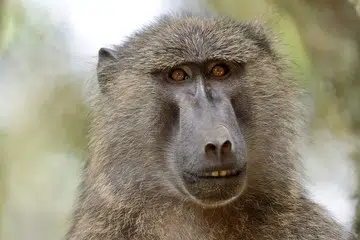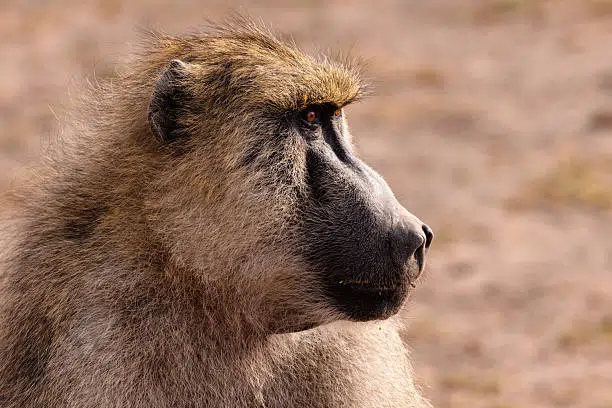Table of Contents
Scientific Classification
| Kingdom | Animalia |
| Phylum | Chordata |
| Class | Mammalia |
| Order | Primates |
| Family | Cercopithecidae |
| Genus | Papio |
| Species | P. cynocephalus |
| Scientific Name | Papio cynocephalus |
1. Description
The Yellow Baboon (Papio cynocephalus) is a fascinating medium-sized primate. With its agile body, expressive face, and impressive social skills, this baboon stands out. Its name comes from its striking yellow-brown coat, and it’s one of five species in the Papio genus. Compared to its relatives, the Chacma and Olive baboons, the Yellow Baboon is a bit slimmer.
Adults have a lean physique, featuring long limbs and a dog-like muzzle. Males tend to be significantly larger than females, weighing in at around 20 to 25 kilograms, while females usually tip the scales at 10 to 15 kilograms. Males also sport large canine teeth, which they use for defense and to assert their dominance. Their tails are quite distinctive, held in a unique arc—downward at the base and curving upward at the tip.
Yellow Baboons have dark skin around their muzzles, and their close-set eyes reveal a surprising depth of emotion and curiosity. Their nimble fingers allow them to move with precision, whether they’re grooming, foraging, or handling tools.
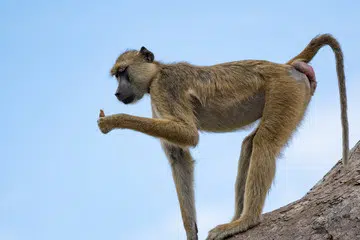
2. Distribution
Yellow Baboons are found in the eastern regions of Africa, with their habitat stretching across Tanzania, Kenya, Zambia, Mozambique, and parts of Zimbabwe and Malawi. They make their home in the Great Rift Valley and surrounding areas, thriving in a variety of landscapes such as open savannahs, wooded grasslands, and even places that have been modified by humans.
You can spot them in national parks like Mikumi in Tanzania and South Luangwa in Zambia. Their ability to adapt has allowed them to maintain robust populations across these diverse ecosystems.
3. Habitat
These fascinating primates thrive in open woodlands, savannahs, and grasslands. They also enjoy the company of riverine forests and scrublands. Unlike their forest-dwelling relatives, Yellow Baboons prefer to stay grounded, although they do climb trees when it’s time to sleep or seek safety.
They’re quite adaptable and can even make their homes near farms and villages, which sometimes leads to clashes with humans. Their strength is evident in both protected and unprotected areas, showcasing their remarkable ability to adjust to different environments.
4. Diet
Yellow Baboons are true omnivores, enjoying a diet that’s as varied as the environments they inhabit. Their food choices shift with the seasons and the regions they roam, but you can usually find them munching on:
– Fruits and seeds
– Grass and leaves
– Roots and tubers
– Insects, scorpions, and small vertebrates
– Bird eggs, and sometimes even small birds or rodents
Foraging is a social affair for these baboons, as they often travel in troops, covering large distances each day in search of their next meal. In agricultural areas, they can be quite the troublemakers, raiding crops like maize, sugarcane, and bananas, which can lead to conflicts with farmers.
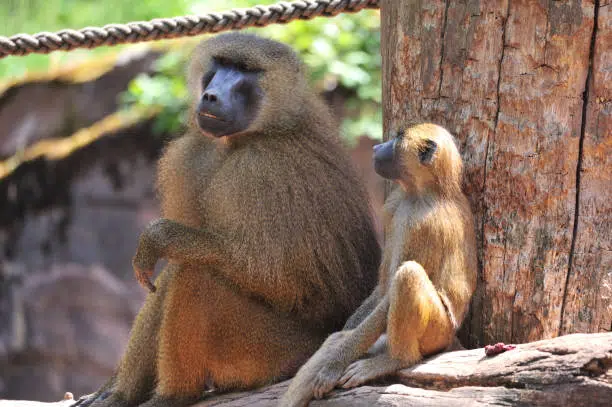
5. Behavior
Yellow Baboons are incredibly social creatures. They form troops that can range from 20 to over 100 individuals, consisting of both males and females. The social structure within these groups is quite intricate, with hierarchy playing a significant role in determining access to mates, grooming opportunities, and feeding rights.
Typically, males take the lead in dominance, but there are also female hierarchies in place. These female ranks are matrilineal, meaning they are passed down from mother to daughter.
Grooming serves as a vital social activity, helping to strengthen bonds and ease any tension among members.
Their communication is rich and varied, encompassing vocalizations, facial expressions, body language, and even specific grooming behaviors. Alarm barks, grunts, and screams are just a few examples of their vocal sounds.
Aggression and submission are expressed through various rituals, including eye threats, yawns that expose their canines, and chasing behaviors.
Troops function as a cohesive unit, often traveling several kilometers each day. While males may move between different troops, females typically stay within their natal groups.
6. Lifespan
In the wild, Yellow Baboons typically live around 20 to 25 years, but some have been known to reach over 30 years when kept in captivity. Their lifespan is influenced by various factors, including predation, food availability, disease, and the impact of humans.
Generally, male Yellow Baboons tend to have shorter lifespans compared to females. This is often a result of competition among males, which can lead to injuries and stress. These challenges are particularly evident during troop integration or when establishing dominance.
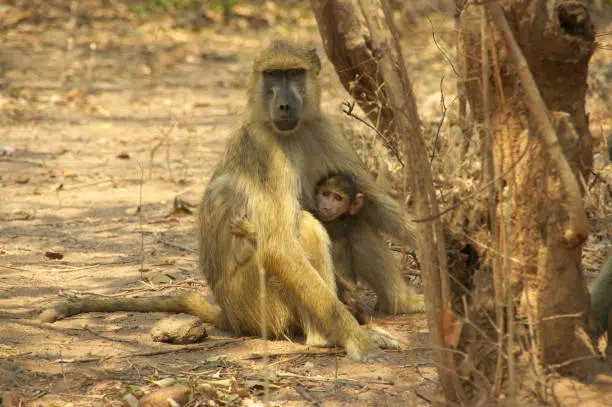
7. Reproduction and Lifecycle
Yellow Baboons have a pretty unique mating system called polygynandry, where both males and females get to mate with multiple partners. When females are ready to mate, they show noticeable signs of fertility through sexual swellings, which prompts males to compete for their attention.
Here are some key stages in their lifecycle:
Gestation Period: Lasts about 6 months, or roughly 180 days.
Birth: Typically, a single infant is born, while twins are quite rare.
Infant Stage: For the first few months, infants cling tightly to their mothers and depend on them heavily.
Weaning: This happens around 6 to 12 months, although it can vary.
Sexual Maturity: Females reach maturity around 4 to 5 years, while males mature a bit later, at 6 to 7 years.
Interestingly, male baboons don’t usually take on a lot of direct parenting responsibilities. However, they may form bonds with certain females and infants, which could help them improve their chances of mating in the future or provide some indirect care.
8. Predators
Despite their size and social nature, Yellow Baboons face several natural predators:
- Leopards – Skilled climbers and ambush hunters that pose a significant threat.
- Lions – May attack baboons when other prey is scarce.
- Crocodiles – Attack them while crossing rivers.
- Eagles – Can target young or isolated individuals.
- Humans – Through habitat loss, hunting, and conflict over crops.
Baboons rely on sentinels and group cohesion to avoid predation. Alarm calls quickly get the troop moving. Adults rush to protect infants or face threats.
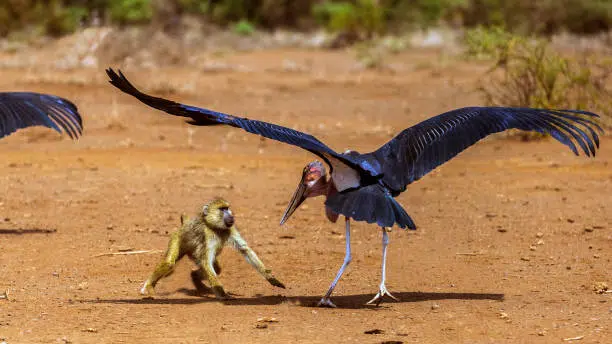
9. Adaptations
Yellow Baboons have many adaptations that help them thrive in East Africa:
- Dexterous hands and opposable thumbs enable tool use and food manipulation.
- Cheek pouches store food during foraging.
- Strong limbs for terrestrial travel and climbing trees for rest or safety.
- Coloration helps them blend into dry grasslands.
- Sharp canine teeth for defense and dominance displays.
They live in large groups with complex relationships. This helps them defend against threats. It also helps them find food better and provide learning chances for the young.
10. Mating Season
When it comes to mating, Yellow Baboons have the flexibility to mate throughout the year. However, you’ll notice that they tend to have more babies during the rainy seasons when there’s an abundance of food. This timing really boosts the chances of survival for their little ones.
Their sexual behavior is heavily influenced by visual signals, especially the noticeable swellings in females. Males often band together in temporary groups, keeping a close watch on receptive females to fend off any rivals until the mating process is complete.
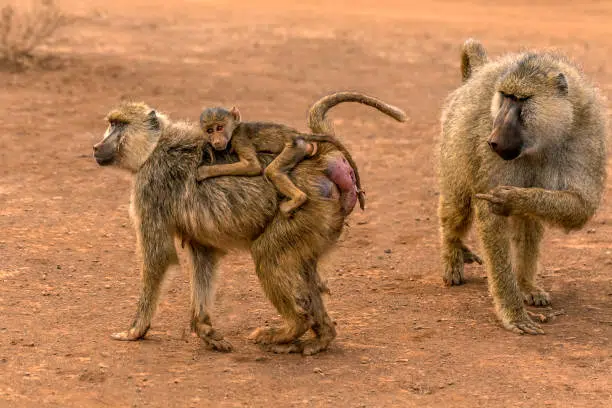
11. Breeding
Mating usually kicks off with the males taking the lead, but receptive females might also seek out their preferred partners. The whole process includes:
– Courtship that involves grooming and physical contact
– Copulation, which often happens multiple times over a few days
– Post-mating partnerships that can last for a while
When infants are born, they come fully furred and with their eyes wide open, clinging closely to their mothers. These mothers are incredibly attentive, and the weaning process is gradual. Sometimes, older siblings or other young ones pitch in to help care for the little ones, a practice known as alloparenting.
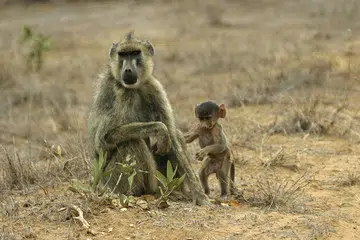
12. Interesting Facts
- Baboon friendships: Male baboons often form strong bonds with females, which not only helps protect them and their young but also increases their chances of mating in the future.
- Yellow Baboons are quite resourceful; they use sticks to hunt for insects or dig up roots, showcasing their impressive problem-solving abilities.
- Human-like behaviors: These animals display emotions similar to ours—they mourn their lost companions, share food, and even experience feelings of jealousy and compassion.
- Vocal complexity: The calls of baboons are quite versatile, changing depending on the situation. They can alert others to predators, signal social disputes, or communicate troop movements. Interestingly, these calls can vary by region, hinting at different cultural dialects among groups.
- Hybridization: In areas where their habitats overlap, Yellow Baboons naturally interbreed with Olive Baboons, resulting in the emergence of mixed populations.
13. Conservation Status
The Yellow Baboon is currently classified as a species of Least Concern on the IUCN Red List. This designation highlights their broad distribution and a healthy, stable population.
That said, there are some localized threats to their survival, including:
– Habitat loss from agriculture, logging, and urban development.
– Hunting for bushmeat or traditional medicine.
– Retaliatory killings by farmers when baboons raid crops.
– Capture for the pet trade or biomedical research.
To help protect them, conservation strategies focus on:
– Safeguarding key habitats and creating buffer zones.
– Encouraging human-wildlife coexistence in farming areas.
– Raising awareness about the vital role baboons play in the ecosystem.
While their adaptability is a significant advantage, their long-term survival hinges on fostering a harmonious relationship with humans.
Conclusion
The Yellow Baboon shows off how adaptable, smart, and social primates can be. Their active lives, such as grooming and bold foraging trips, show the roots of human behavior. Their conservation status is stable for now. Habitat loss and human conflict show us that adaptable species can still struggle.
